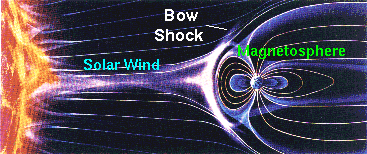 |
| The Earth's magnetic field and Van Allen radiation belts |
The Earth has a substantial magnetic field, a fact of some historical importance because of the role of the magnetic compass in exploration of the planet.
 |
| The Earth's magnetic field and Van Allen radiation belts |
It is well known that the axis of the magnetic field is tipped with respect to
the rotation axis of the Earth. Thus, true north (defined by the direction to
the north rotational pole) does not coincide with
magnetic north (defined by the direction to the north magnetic pole)
and compass directions must be corrected by fixed amounts at
given points on the surface of the Earth to yield true directions.
Van Allen Radiation Belts
 A fundamental
property of magnetic fields is that they exert forces on moving electrical
charges.
Thus, a magnetic field can trap
charged particles
such as electrons
and protons as they are forced to execute a
spiraling motion back and forth
along the field lines.
A fundamental
property of magnetic fields is that they exert forces on moving electrical
charges.
Thus, a magnetic field can trap
charged particles
such as electrons
and protons as they are forced to execute a
spiraling motion back and forth
along the field lines.
As illustrated in the adjacent figure, the charged particles are reflected at "mirror points" where the field lines come close together and the spirals tighten. One of the first fruits of early space exploration was the discovery in the late 1950s that the Earth is surrounded by two regions of particularly high concentration of charged particles called the Van Allen radiation belts.
The inner and outer Van Allen belts are illustrated in the top figure. The primary source of these charged particles is the stream of particles emanating from the Sun that we call the solar wind. As we shall see in a subsequent section, the charged particles trapped in the Earth's magnetic field are responsible for the aurora (Northern and Southern Lights).
Rocks that are formed from the molten state contain indicators of the magnetic field at the time of their solidification. The study of such "magnetic fossils" indicates that the Earth's magnetic field reverses itself every million years or so (the north and south magnetic poles switch). This is but one detail of the magnetic field that is not well understood.
 The solar wind mentioned above is a stream of ionized gases that blows outward
from the Sun at about 400 km/second and that varies in intensity with the
amount of surface activity on the Sun. The Earth's magnetic field shields it
from much of the solar wind. When the solar wind encounters Earth's magnetic
field it is deflected like water around the bow of a ship, as illustrated in the adjacent
image
(Source).
The solar wind mentioned above is a stream of ionized gases that blows outward
from the Sun at about 400 km/second and that varies in intensity with the
amount of surface activity on the Sun. The Earth's magnetic field shields it
from much of the solar wind. When the solar wind encounters Earth's magnetic
field it is deflected like water around the bow of a ship, as illustrated in the adjacent
image
(Source).
The imaginary surface at which the solar wind is first deflected is called the bow shock. The corresponding region of space sitting behind the bow shock and surrounding the Earth is termed the magnetosphere; it represents a region of space dominated by the Earth's magnetic field in the sense that it largely prevents the solar wind from entering. However, some high energy charged particles from the solar wind leak into the magnetosphere and are the source of the charged particles trapped in the Van Allen belts.